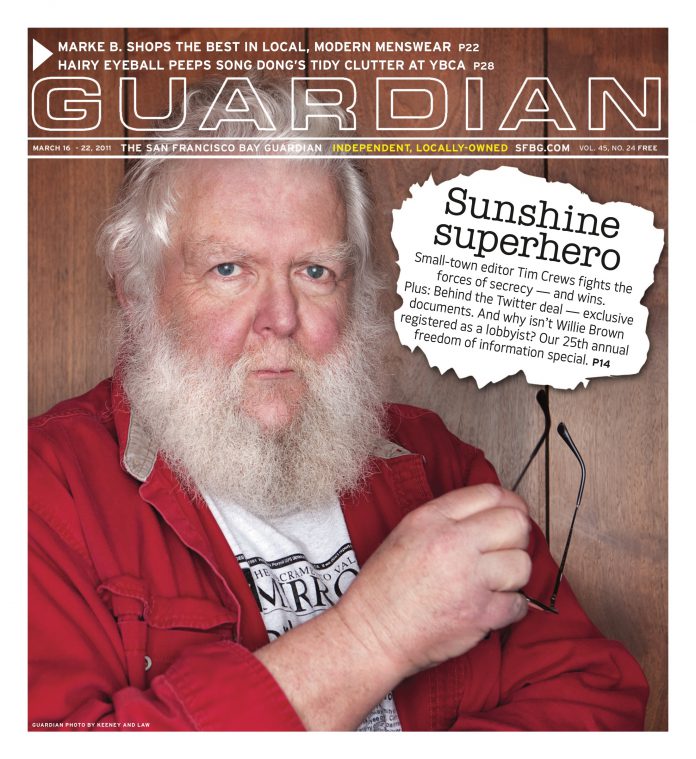arts@sfbg.com
DANCE Forty is the time when the midlife crisis is supposed to hit, but there’s no sign that ODC is even close. At its short but sweet gala performance on March 11, which opened this year’s three-week “Dance That Matters” program, the artists looked stunning, the choreography fresh and fun, and the audience thoroughly pleased. What more would you want? A home that is paid for? ODC has it. Some money in the bank? ODC has enough to stay alive. Plans for the future? Yes: more dance, and something called the ODC Campus that might include housing for dancers and perhaps even college degrees.
The gala featured new works by Brenda Way and Kimi Okada. (KT Nelson’s Listening Last, a collaboration with Shinichi Iova-Koga, premieres this week.) For the celebratory yet pensive Speaking Volumes: Architecture of Light II, Way reworked the installation piece that ODC’s company reopened its theater with last year. Speaking is linear and therefore allows for a different trajectory. Way takes stock of a dancer’s life, from the working individual to the end of a career that gets absorbed into a mass of humanity. Thirty-five current, former, and recreational dancers flooded the stage for a communal celebration of dance. Along the way, they regaled us with aphorisms along the lines of “Art gives shape to life,” and “Don’t be afraid of people seeing your ideas.” Their energetic optimism is characteristic of Way.
Speaking opened with Jeremy Smith following a voice-over instruction for a new piece. (For example: “Make a triangle with your arm … stick your head through it.”) His responses, sometimes literal, other times imagistic, were fascinating. Then flashlights began to search, a little too long, for potent ideas among dancers half-hidden in the dark.
The lights found, among other treasures, a quintet that reminded me of frolicking dogs and a fluidly stretched give-and-take trio for Dennis Adams, Quilet Rarang, and Vanessa Thiessen that allowed sparks to fly between friendly moments of repose. Fierceness and volatility without rancor propelled Elizabeth Farotte Heenan and Daniel Santos’s duet. At the end of Speaking, they embraced. (Farotte Heenan is retiring.)
Associate choreographer Okada runs ODC’s school and its mentorship program, so she choreographs little these days. That’s why I look vacantly at the Pacific … though regret — a humorous look at misunderstandings, erroneous assumptions, and long-held behavioral patterns — was so welcome. Good intentions won’t keep you from making faux pas in a world that values “diversity.” Yet Okada’s take is so witty and good-natured that it would take a real curmudgeon of political correctness to take offense at this light-hearted consideration of a serious subject.
Look moves speedily through awkward encounters; it presents a world that’s a merry-go-round from which there is no escape. Anne Zivolich, hair flying, skipped through the chaos. The English language can yield rich images, and Okada’s choreography also presents more than a few. Two men literally bite the bullet; Yayoi Kambara points a Medusa finger and everyone freezes. Jerky, fragmented movement illustrates the topsy-turvy results of linguistic maneuvering to oft-comic effect.
But there is more to the piece, namely its navigation of culture gaps. In a smartly-timed encounter, two couples try to greet each other. One bows, the other outstretches hands. Each attempt to connect only drives them further apart. During one of Look‘s funniest moments, Jay Cloidt introduces a section of Japanese classical music. The dancers freeze in terror and embarrassment. Rubbery-limbed Santos, clad in a business suit, tries to toe the line — here we go with an image — but falls all over himself. He had my sympathy. *
ODC/DANCE DOWNTOWN: A FORCE AT 40
Through March 27; $20
Yerba Buena Center for the Arts, Novellus Theater
701 Mission, SF
(415) 978-2787

